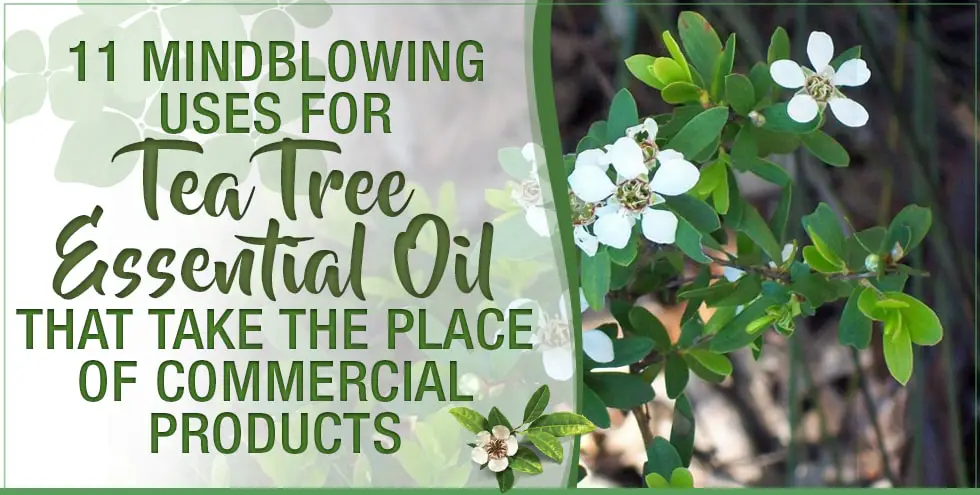With its incredible variety of health benefits, tea tree oil is an extremely popular essential oil that is used to treat a multitude of common issues. In addition to its potent minty aroma, this oil boasts the ability to knock out a wide variety of common infections, keep insects away, enhance one’s beauty and so much more.
[vision_pullquote style=”3″ align=”center”] Click Here To Quickly View This Page In One Image!
Tea Tree Essential Oil Benefits Infographic[/vision_pullquote]
 1. Knock Out Colds and Other Viruses without Relying on Drugs
1. Knock Out Colds and Other Viruses without Relying on Drugs
Tea tree oil is renowned for its antiviral properties. Over the years, a tremendous amount of research has demonstrated that tea tree oil can successfully treat several common viruses including the human papilloma virus, influenza and herpes (source).
One study specifically tested the oil’s ability to treat herpes. The study compared tea tree oil and eucalyptus oil as treatments for the herpes virus. While eucalyptus oil also has strong antiviral properties, the study concluded that tea tree oil has a remarkable impact on viruses. In fact, the oil was capable of destroying 75 percent of the viral cells (source).
[amazon box=”B018J6KIBW”]
The Easy Inhalation Method for Colds and Other Internal Viruses
- Remove the lid from an oil diffuser.
- Fill the tank of the oil diffuser with water without exceeding the maximum fill line.
- Remove the cap from a bottle of tea tree essential oil. Angle the bottle so that its spout is leaning toward the water in the tank of the oil diffuser.
- Tap the side of the bottle of tea tree oil with one finger to release about four drops into the water.
- Return the lid to the oil diffuser.
- Plug the oil diffuser into an outlet in the room that you will be occupying.
- Turn the oil diffuser on. Sit a few feet away from the oil diffuser as it releases scented steam. Focus on taking long, deep breaths.
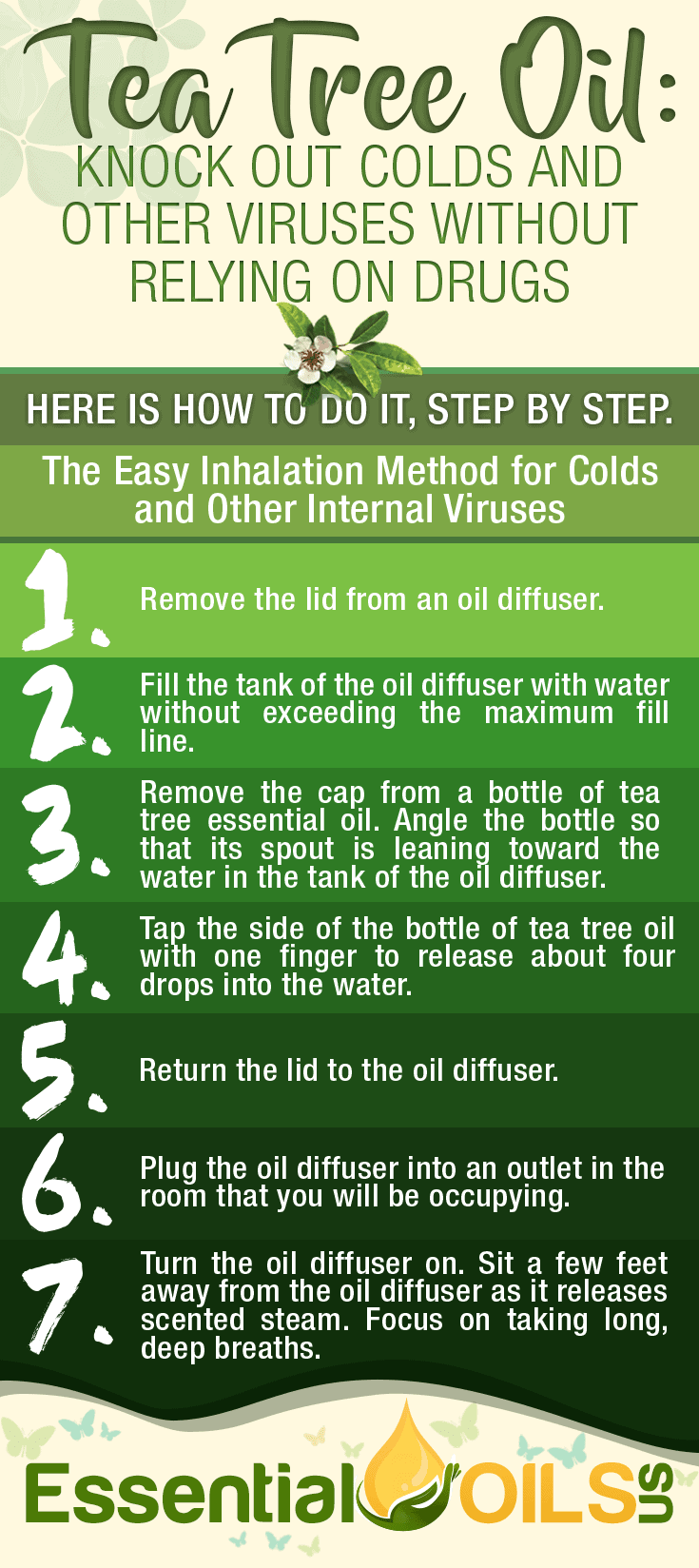
The Topical Application Method for Herpes and Other External Viruses
- Remove the lid from a 20oz plastic bottle that is empty and clean.
- Using a funnel if you wish, fill the bottle to the top with a thin carrier oil such as olive oil.
- Twist off the lid of a bottle of tea tree oil. Position the bottle of tea tree oil upside down and place it directly above the mouth of the plastic bottle.
- Shake the bottle of tea tree oil vigorously so that about 30 drops fall into the carrier oil.
- Twist the cap back onto the plastic bottle and shake the bottle aggressively for about 45 seconds.
- Each day, pour about one tablespoon of the oil into one palm. Rub both palms together and massage the oil into the affected area using circular motions until the oil has absorbed into the skin.
 2. Treat a Painful Sore Throat Instantly by Gargling Tea Tree Oil
2. Treat a Painful Sore Throat Instantly by Gargling Tea Tree Oil
A sore throat is caused by inflammation of the mucus membranes that run along the bronchial tubes. When these membranes are inflamed, usually as the result of an infection, they become swollen and painful.
As a potent anti-inflammatory, tea tree oil can reduce inflammation in the throat quickly with a simple gargle of the oil diluted in water. Its strong anti-inflammatory effects will reduce pain and swelling quickly (source).
The Throat-Soothing Gargle Method
- Fill a drinking glass with one half of a cup of water.
- Twist the cap off of your tea tree oil bottle. Angle the bottle so that its spout is leaning toward the water in the glass.
- Very gently tap the side of the tea tree oil bottle so that no more than two drops fall into the water.
- Stir the mixture for 10 seconds.
- Pour the contents of the glass into your mouth and gargle for 30 seconds before spitting it out into the sink. Be extremely careful not to swallow the mixture. You may do this twice each day until the sore throat has gone away.
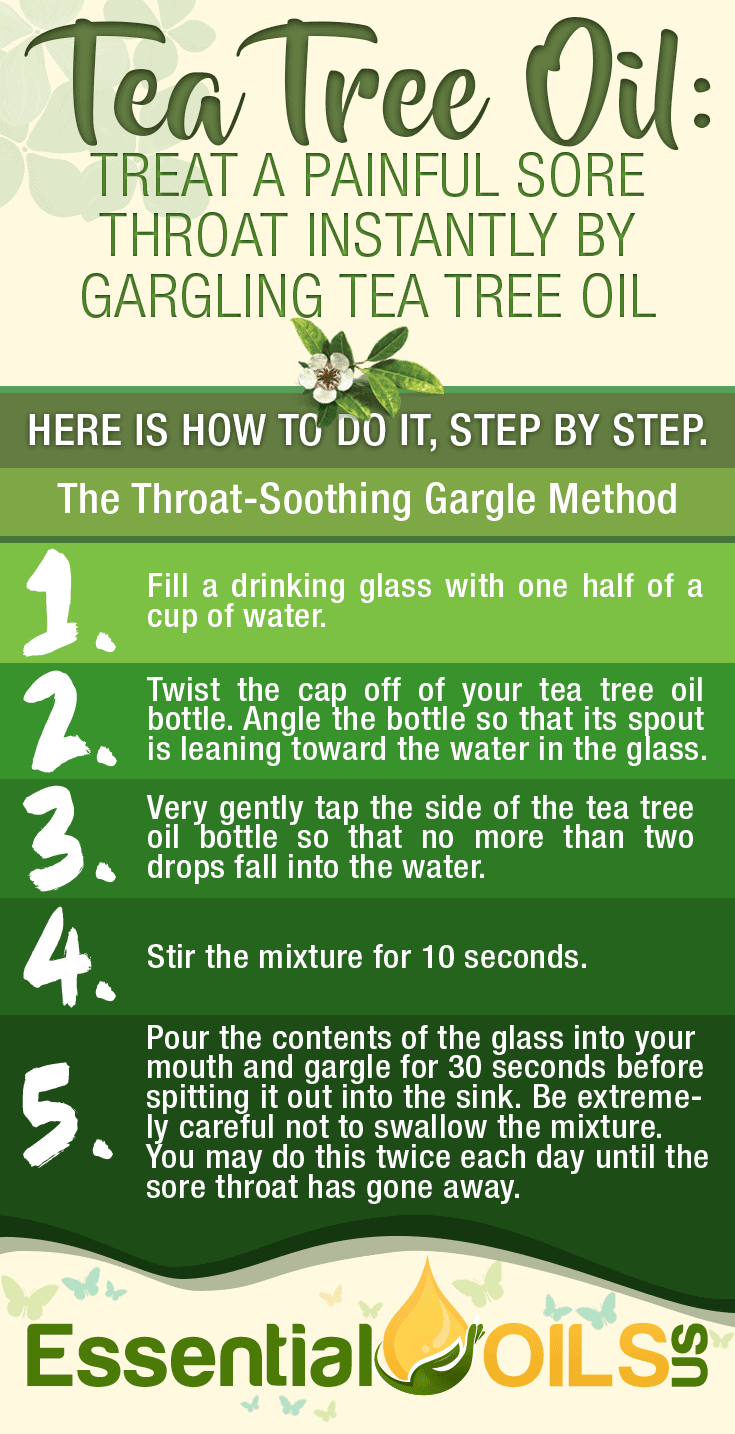
 3. Achieve a Clear Complexion and Say Goodbye to Unsightly Pimples
3. Achieve a Clear Complexion and Say Goodbye to Unsightly Pimples
When the skin’s pores become infected with bacteria, the skin surrounding the pores becomes red, swollen and irritated as the result of inflammation. A pimple is nothing more than an infected and inflamed pore. Unfortunately, acne affects a tremendous portion of the population as there are many contributing factors to acne that include hormone changes, poor hygiene and poor diet.
Every drug store is loaded with commercial skincare products that promise to fight acne. Unfortunately, many of these products simply don’t work. Plus, they are often loaded with harsh ingredients that can cause severe skin dryness. Prescription acne medications may be effective but are notorious for their side effects including mood changes and hormonal imbalances.
Luckily, tea tree essential oil is a safe and highly effective treatment for managing acne. As a spot treatment, tea tree oil can kill pimples practically overnight. This is because of the oil’s powerful antibacterial and anti-inflammatory properties.
One study tested several different acne treatment products to compare their effectiveness. Tea tree oil is just as effective when it comes to treating acne as many popular over-the-counter topical acne products (source).
The Spot Treatment Method for Super Clear Skin
- Twist off the cap of a bottle of tea tree essential oil.
- Place the bottle upside down and position it over your palm.
- Gently shake the bottle of tea tree oil, allowing a few drops to fall into your palm.
- Dip a q-tip into the tea tree oil that has collected in your palm. Then, dab this oil-soaked q-tip onto a pimple.
- You may repeat this process for each pimple. You may do this once each day until the pimples have disappeared.
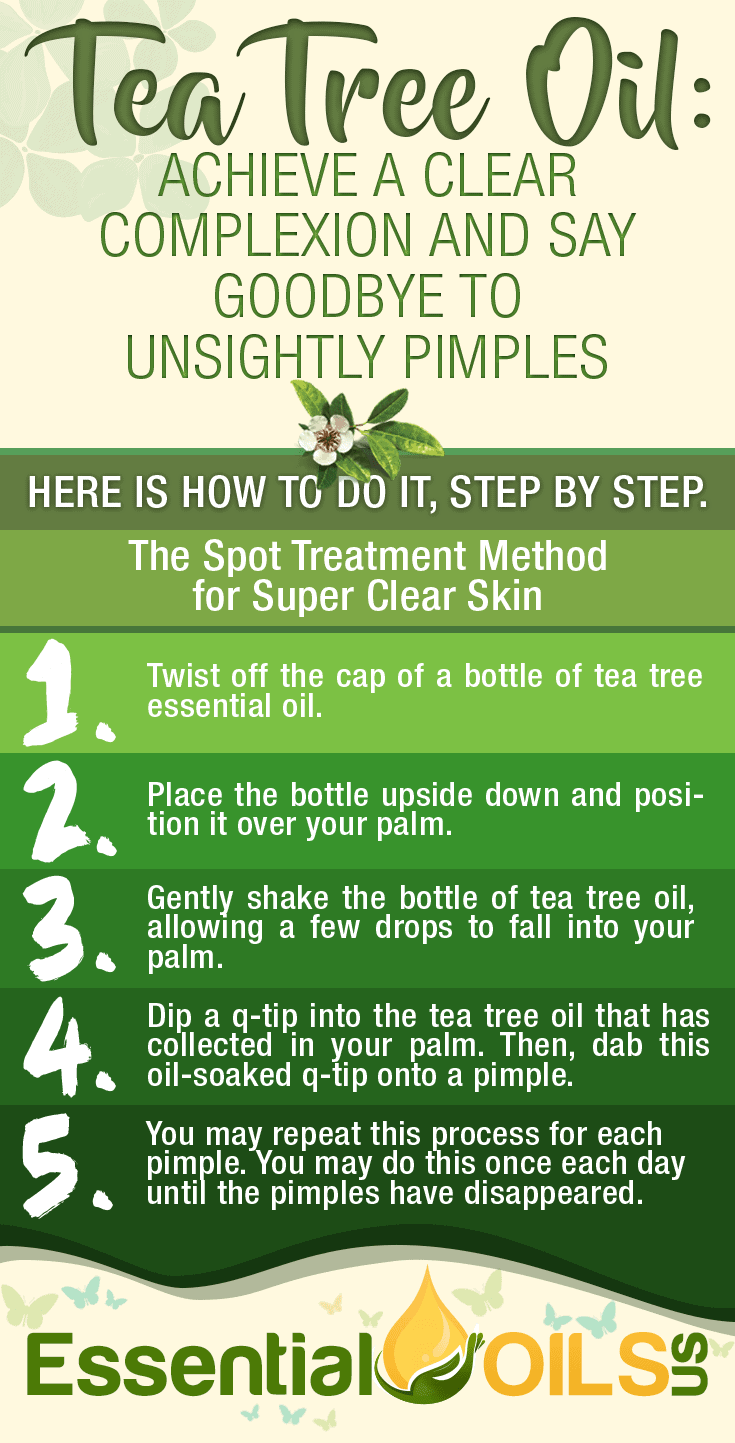
 4. Keep Your Household Clean and Germ-Free with Tea Tree’s Minty Fresh Scent
4. Keep Your Household Clean and Germ-Free with Tea Tree’s Minty Fresh Scent
Thanks to its powerful antimicrobial, anti-fungal and antibacterial properties, tea tree essential oil can keep your home free of dangerous germs while providing it with a fresh, minty aroma that will mask bad household odors.
Studies have shown that when it comes to killing common household microorganisms, few things are as effective as tea tree oil. Its unique combination of chemical compounds allows it to destroy an enormous variety of germs that can be harmful to one’s health (source).
One particular study tested tea tree oil’s ability to kill five of the most common bacteria including E. coli. The oil’s powerful ability to eradicate this bacteria demonstrates its effectiveness as a household cleaner that can prevent dangerous foodborne illnesses (source).
Tea tree oil is also known for its potent anti-fungal properties. Therefore, it can kill household mold in no time.
The “Germ-Free Home” Spray Method
- Remove the cap from a 20oz clean and empty plastic spray bottle.
- Fill the spray bottle with white vinegar. You may use a funnel to make pouring easier.
- Remove the cap from a bottle of tea tree essential oil. Angle the bottle so that its spout is directly facing the vinegar in the spray bottle.
- Shake the bottle of tea tree essential oil aggressively, allowing about 30 drops to fall into the vinegar.
- Return the cap to the plastic spray bottle. Shake the bottle vigorously for 45 seconds.
- You may spray this mixture onto surfaces in your home.
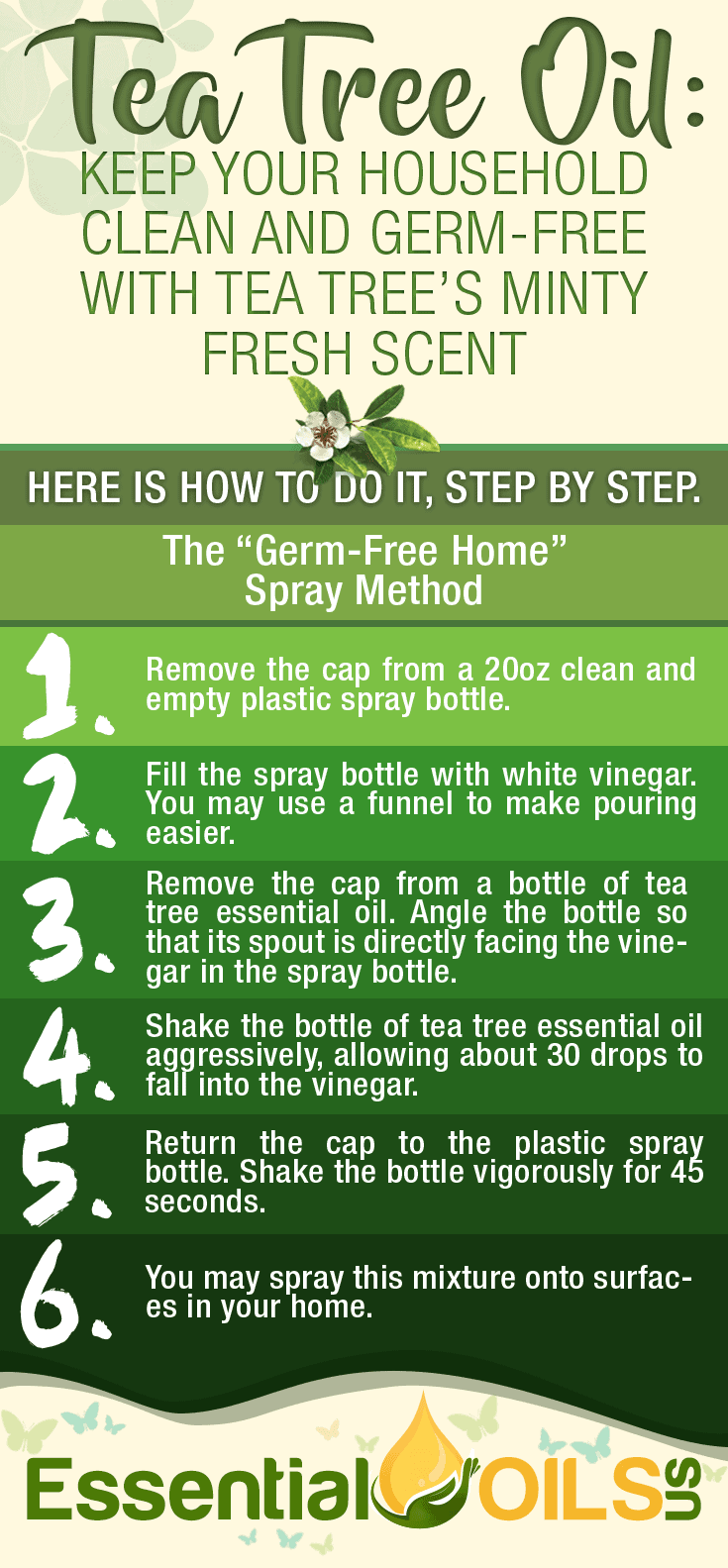
 5. Kill Head Lice Quickly and Prevent Them from Coming Back
5. Kill Head Lice Quickly and Prevent Them from Coming Back
Head lice are parasitic insects that inhabit human scalps and feed off of blood. These lice are easily transmitted from one person to another, making this condition highly contagious.
There are several commercial shampoo products on the market that combat head lice. Unfortunately, few of these shampoo products are highly effective.
However, recent studies have determined that tea tree oil has the ability to kill head lice. In addition to killing adult lice, the oil is capable of preventing lice eggs from hatching (source).
Another study involved the topical application of tea tree essential oil to the scalps of children suffering from head lice infestations. Astoundingly, almost every single child in the study was free of head lice as a result of the oil’s powerful anti-parasitic properties (source).
The Super Lice-Killing Shampoo Method
- Twist the cap off of a bottle of shampoo that you use daily.
- Twist the cap off of a bottle of tea tree essential oil.
- Angle the bottle of tea tree oil so that its spout is facing the shampoo bottle.
- Shake the bottle of tea tree oil so that about 25 drops fall into the shampoo.
- Twist the lid back onto the shampoo bottle. Shake the shampoo bottle vigorously for about 60 seconds.
- Shampoo as you normally do twice a day until the lice infestation is gone. You may continue to use this shampoo after the lice have disappeared to prevent a future infestation.
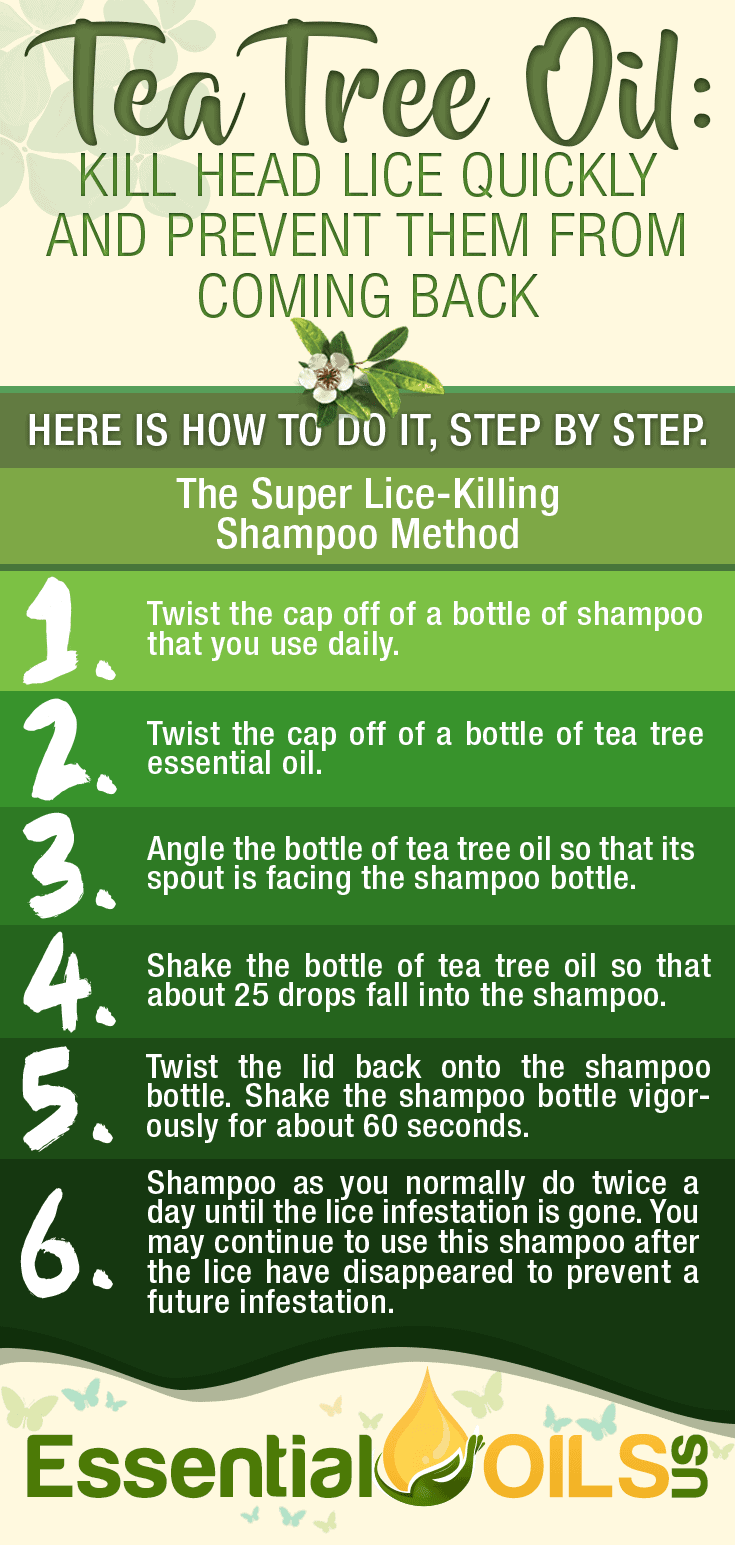
 6. Improve Your Oral Health and Have Minty Fresh Breath
6. Improve Your Oral Health and Have Minty Fresh Breath
Tea tree essential oil has several positive effects on oral health. For one thing, its anti-inflammatory properties can soothe inflamed gums and toothaches (source).
The antimicrobial and antibacterial properties of tea tree oil give it the ability to kill a variety of common bacteria that can cause serious problems like tooth decay and periodontal disease. These common conditions are simply the result of an abundance of bacteria lingering around the teeth and gums. As the bacteria multiplies, damage to the gums and teeth is inevitable. Tea tree oil has been shown to eradicate this bacteria almost immediately, making it a powerful product for maintaining good oral health.
Plus, the undeniably potent minty scent of tea tree oil will mask the odors associated with bad breath. By simply swishing with the oil daily, bad breath will be masked and the bacteria causing the bad breath will be destroyed.
[amazon box=”B00QJCFWSI”]
The Germ-Fighting Rinse Method for Fresh Breath and Happy Teeth and Gums
- Into a drinking glass, pour one half of a cup of water.
- Twist the cap off of a bottle of tea tree essential oil. Angle the bottle so that its spout is leaning toward the mouth of the glass.
- Gently tap the side of the oil bottle with one finger. Allow no more than two drops of oil to fall into the water.
- Stir the oil into the water for about 15 seconds.
- Pour the contents of the glass into your mouth. Swish the mixture for about 30 seconds before spitting it out into the sink. Be careful not to swallow any of this mixture. You may do this twice each day.
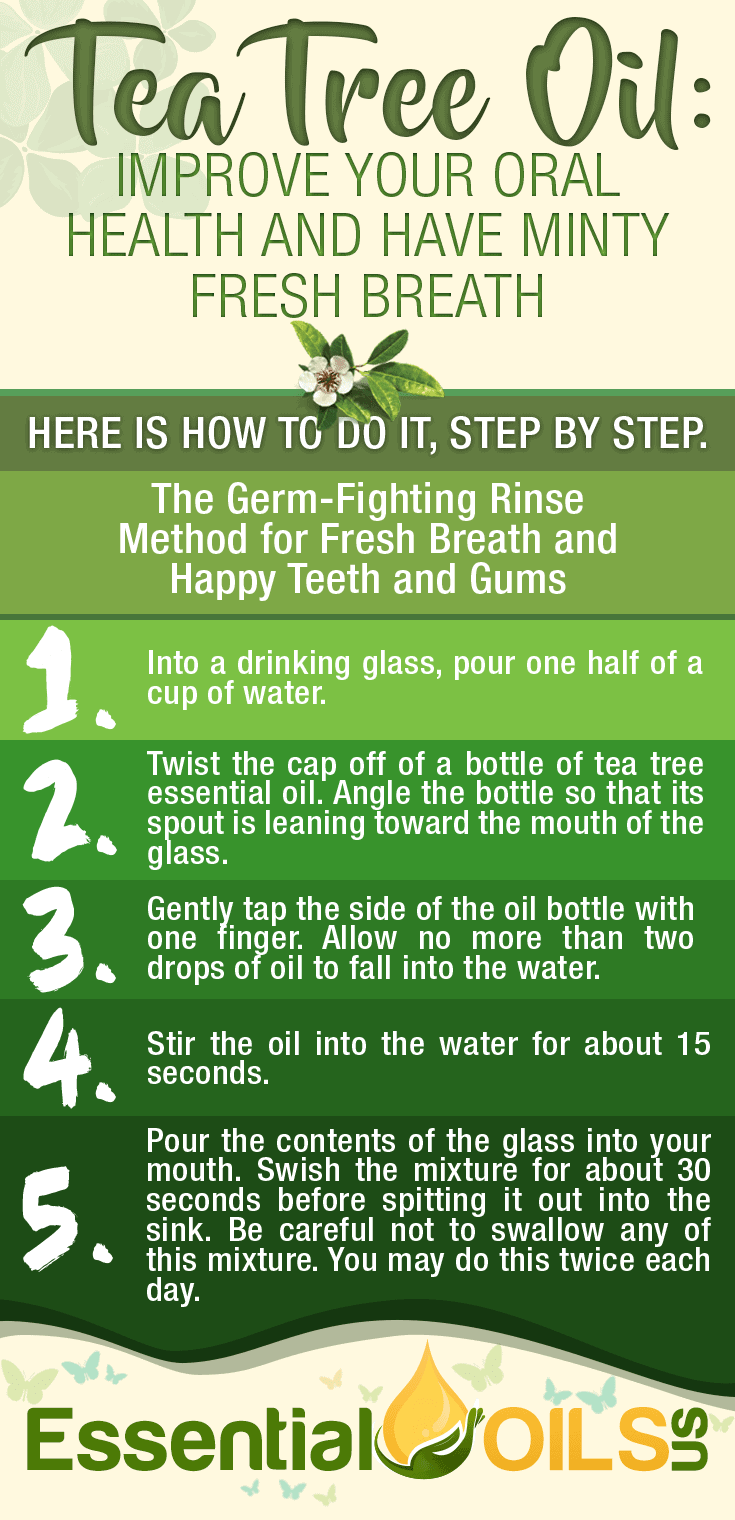
 7. Keep Pesky Bugs Away for Good
7. Keep Pesky Bugs Away for Good
Tea tree oil is a powerful bug repellent thanks to its incredibly potent aroma. In fact, it has been proven to be a powerful insecticide used by farmers to keep bugs away from crops (source).
This essential oil keeps away and kills a variety of pests including ants, mosquitoes and spiders. In fact, one study has proven that tea tree essential oil can even kill scabies.
Because of the variety of pests that it can both repel and kill, there are many ways to use this oil for its repellent purposes. You can spray it on yourself to keep mosquitoes away during the summer months. You can spray it in your garden to keep insects away from your plants. You can also spray it around your home to keep away common indoor pests such as spiders and ants.
The Ultimate Bug-Repelling Spray Method
- Twist the cap off of a 20oz plastic spray bottle that is empty and clean.
- Fill the spray bottle with water.
- Remove the cap from your bottle of tea tree essential oil. Hold the bottle upside down directly over the mouth of the spray bottle.
- Aggressively shake the tea tree oil bottle so that about 30 drops fall into the spray bottle.
- Screw the cap back onto the spray bottle and shake the bottle for about 45 seconds.
- You may use this spray liberally on skin, around your home and in your garden.
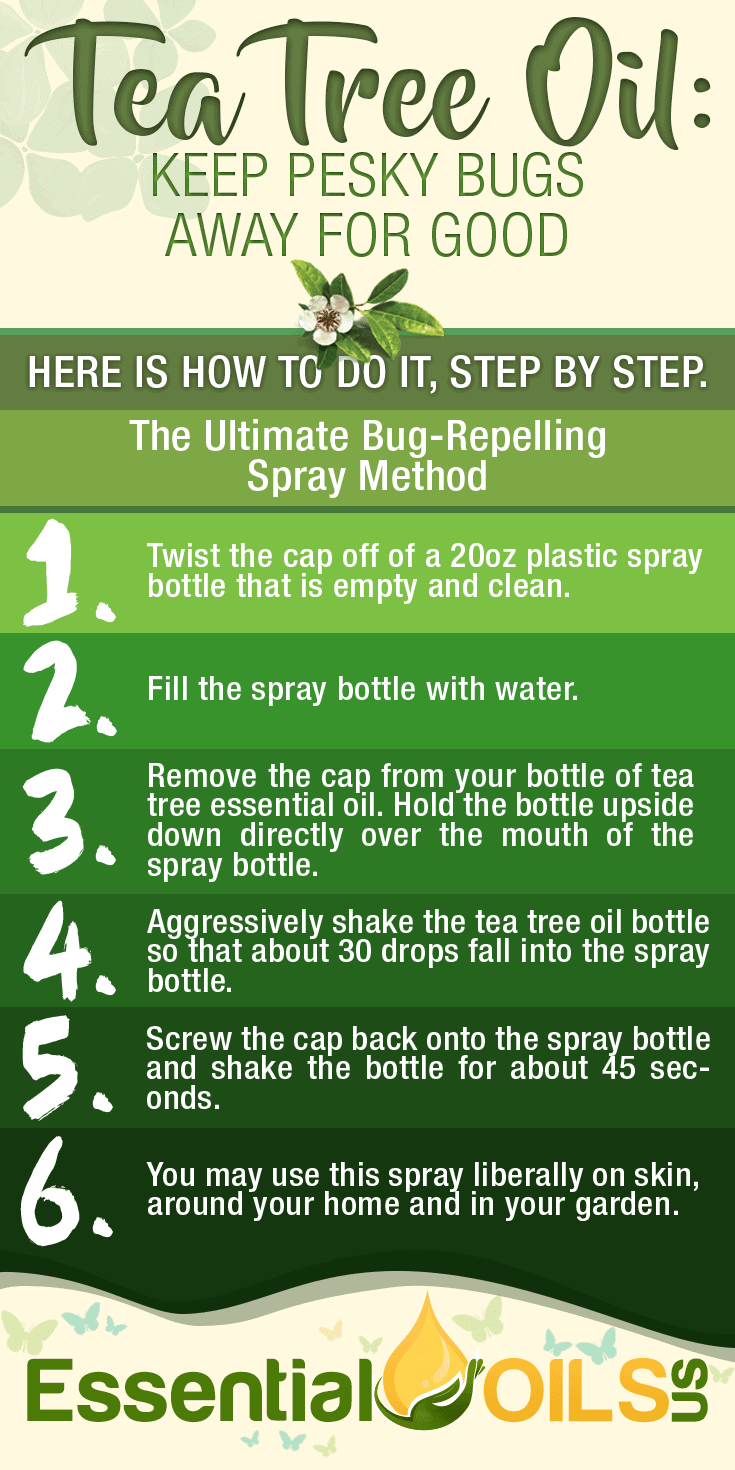
 8. Destroy Fungal Infections Safely and without Dangerous Medications
8. Destroy Fungal Infections Safely and without Dangerous Medications
Fungal infections can wreak havoc on someone’s life. Common infections include toenail fungus, ringworm and yeast infections. Many doctors prescribe strong antibiotics to knock out fungal infections. The problem is that taking too many antibiotics can actually cause more severe fungal infections like candida if used over a long period of time (source).
Luckily, tea tree oil is a highly effective anti-fungal remedy that can destroy most fungal infections that exist externally on the body. For thousands of years, the oil has been used to get rid of fungal infections including vaginal yeast infections and ringworm (source).
The Fungus-Fighting Topical Application Method
- Pour two tablespoons of coconut oil into a small bowl.
- Twist the cap off of a bottle of tea tree oil.
- Angle the bottle of tea tree oil so that its spout is leaning over the bowl.
- Tap the side of the bottle of tea tree oil with one finger, allowing about six drops to fall into the bowl.
- Using a spoon or a fork, stir the two oils together for about 20 seconds.
- Dip a cotton ball into the oil mixture. Then, dab the affected area with the oil-soaked cotton ball.
- You may do this twice each day until the fungal infection disappears.
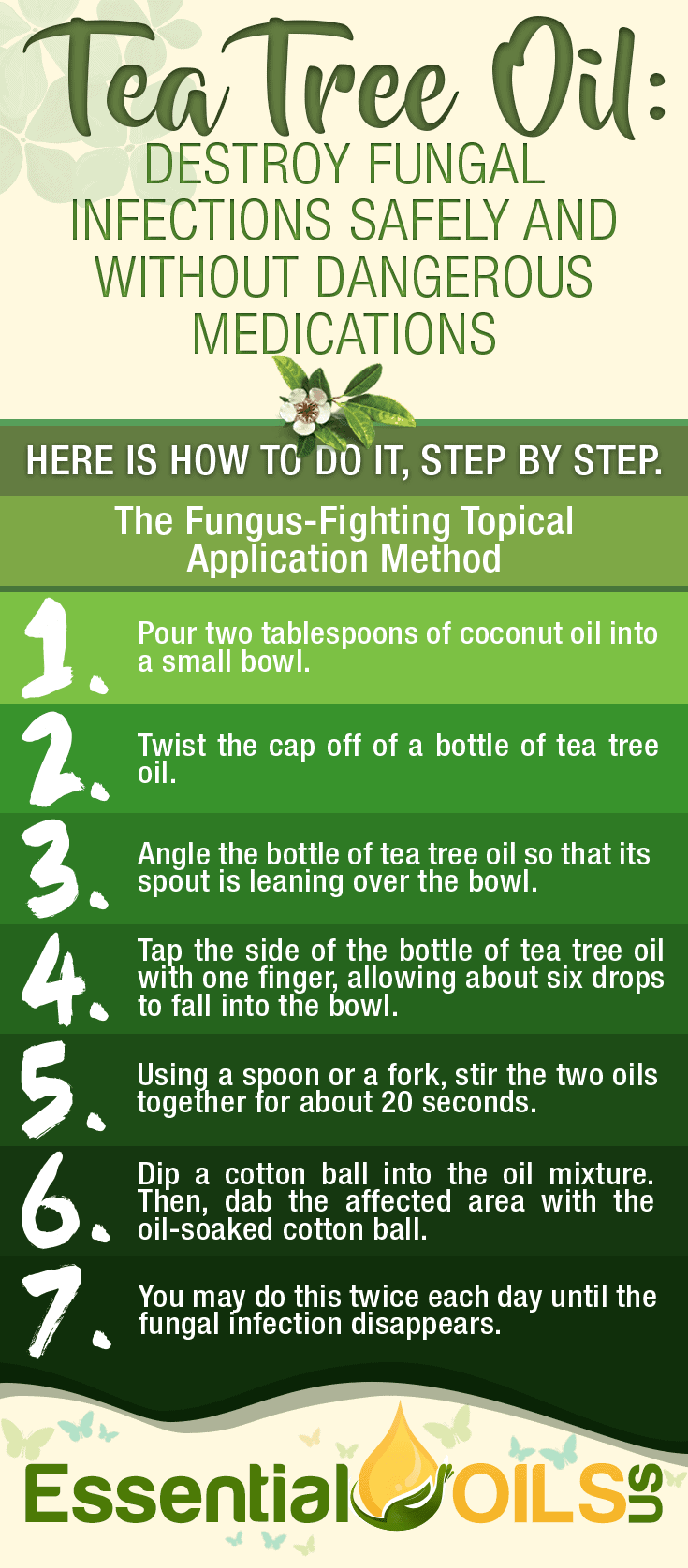
 9. Stimulate Hair Growth for Long, Thick and Healthy Locks
9. Stimulate Hair Growth for Long, Thick and Healthy Locks
Tea tree essential oil has been used for centuries as a remedy for hair loss or thinning of the hair. The oil stimulates hair growth by activating the follicles on the scalp.
Part of the oil’s ability to stimulate hair growth has to do with its anti-fungal, antibacterial and anti-inflammatory properties. For many, hair loss or thinning of the hair is caused by fungal or bacterial infections on the skin of the scalp. As a result, hair follicles become inflamed and the skin begins to flake. As the hair follicles become more and more damaged by the infection, dead skin accumulates around the follicles, blocking new hair from growing (source).
Because of its anti-fungal and anti-inflammatory properties, tea tree oil can also treat dandruff and other skin conditions of the scalp.
The Topical Application Method for Thicker, Longer Hair
- Twist the cap off of a clean and empty 20oz plastic bottle.
- Fill this bottle with a carrier oil such as jojoba oil or sweet almond oil. To make pouring easier, you may use a funnel.
- Remove the cap from a bottle of tea tree essential oil. Turn the bottle upside down and hold it over the mouth of the plastic bottle.
- Shake the bottle of tea tree oil so that about 30 drops fall into the plastic bottle.
- Return the cap to the plastic bottle and shake the bottle for about 45 seconds.
- Once a day, before you shampoo, massage this oil into your scalp thoroughly. To do this, simply pour about two tablespoons of the oil into one palm and then rub both palms together.
- Allow the oil to sit for 20 minutes before rinsing it out thoroughly with water or shampoo.
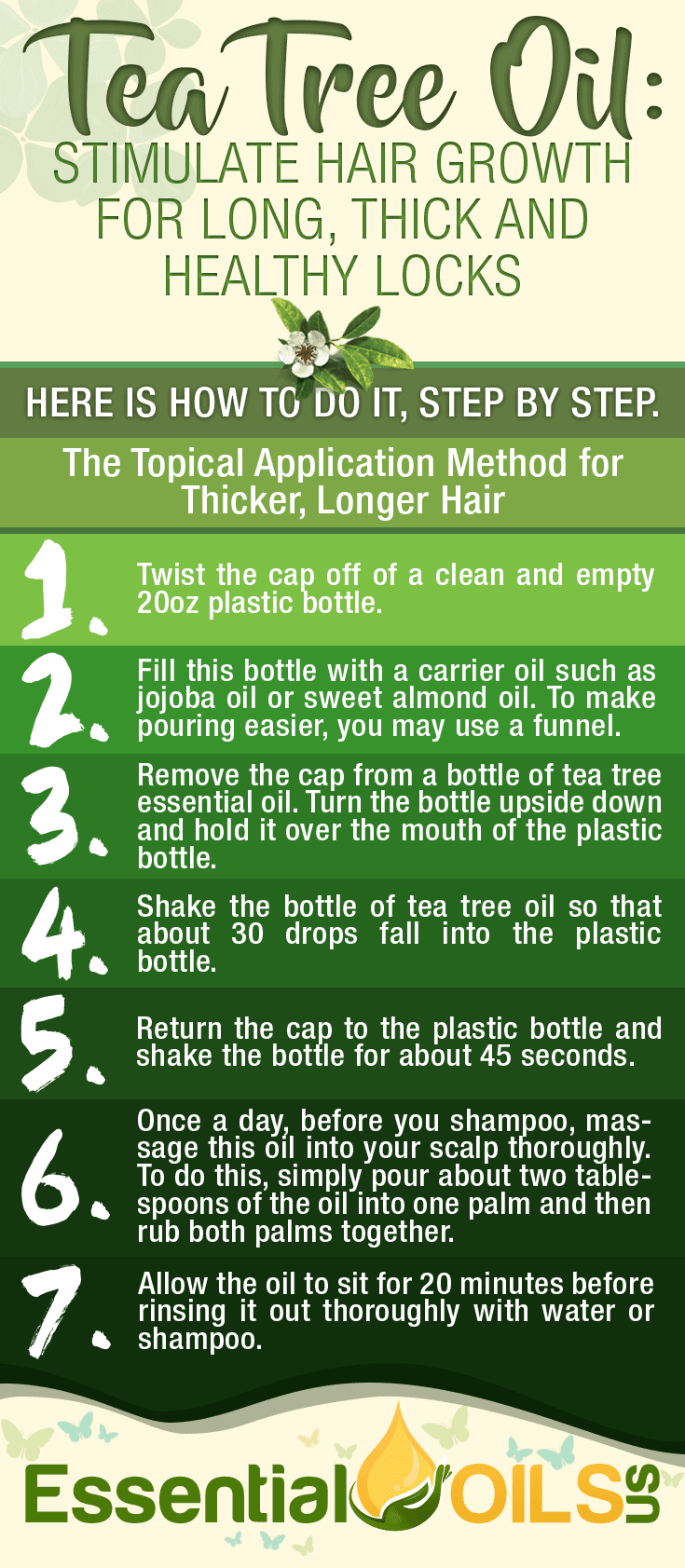
 10. Prevent Cuts and Scrapes from Becoming Infected
10. Prevent Cuts and Scrapes from Becoming Infected
We all get cuts and scrapes from time to time. While it’s easy to bandage them up and go on with the day, it’s extremely important to take the time to clean them thoroughly to prevent dangerous infections from developing. Tea tree essential oil can clean cuts and scrapes thoroughly thanks to its potent antibacterial, antiseptic and antimicrobial properties (source).
In fact, one study shows that tea tree essential oil has the unique ability to fight against a common and dangerous strain of staph bacteria. The oil’s unique blend of chemical compounds allows it to fight against an astounding number of dangerous germs that can lead to potentially life-threatening infections (source).
The Easy and Quick Topical Application Method for Cuts and Scrapes
- Twist the cap off of a bottle of tea tree oil.
- Hold the bottle of oil upside down and directly over the wound. Tap the side of the bottle with one finger so that one or two drops fall directly onto the wound.
- Using a cotton ball, lightly dab the oil into the wound until the oil has been fully absorbed.
- You may do this twice a day until the wound has healed.
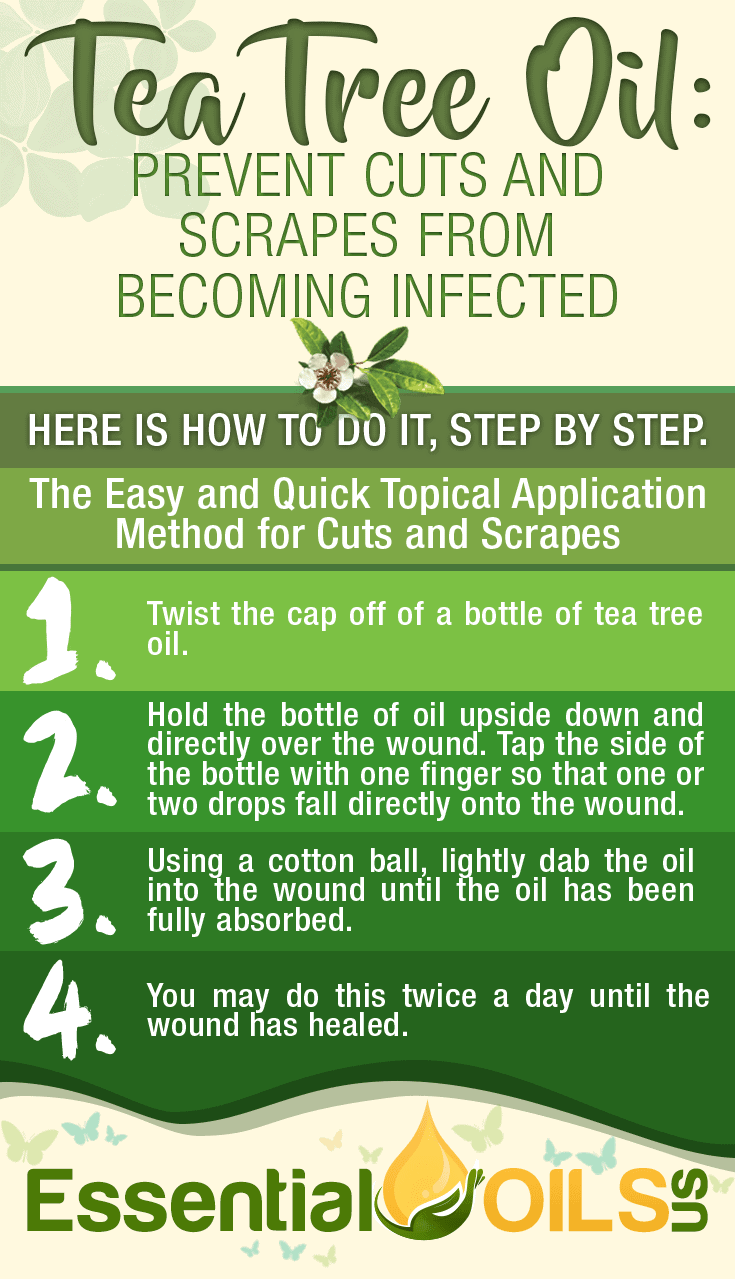
 11. Treat Painful Sinus Headaches without Taking Strong Pain Medications
11. Treat Painful Sinus Headaches without Taking Strong Pain Medications
Headaches are remarkably common and most people will suffer from several headaches throughout their lifetimes. While it’s tempting to reach for a strong pain medication to eliminate the symptoms of a headache, it’s much better to turn to tea tree essential oil instead.
Many pain relievers come with dangerous side effects. Even over-the-counter pain medications can cause damage to the liver and kidneys as well as the digestive tract.
However, tea tree essential oil can treat sinus headaches without any of these dangerous side effects. By simply inhaling the oil, the congestion causing the sinus headache will dissipate in no time. That’s because tea tree oil is an expectorant, meaning that it breaks up excess mucus that causes congestion. As an anti-inflammatory, the oil also reduces swelling of the sinus cavities that can cause pain (source).
[amazon box=”B00PHVXIQA”]
The Pain-Relieving Quick Inhalation Method for Congested Sinuses
- Twist the cap off of a bottle of tea tree essential oil.
- Bring the bottle up to your nose so that its spout is directly below one nostril.
- For one minute, take long, deep breaths through your nose.
- You may repeat this process throughout the day until your sinuses have cleared and your headache has gone away.
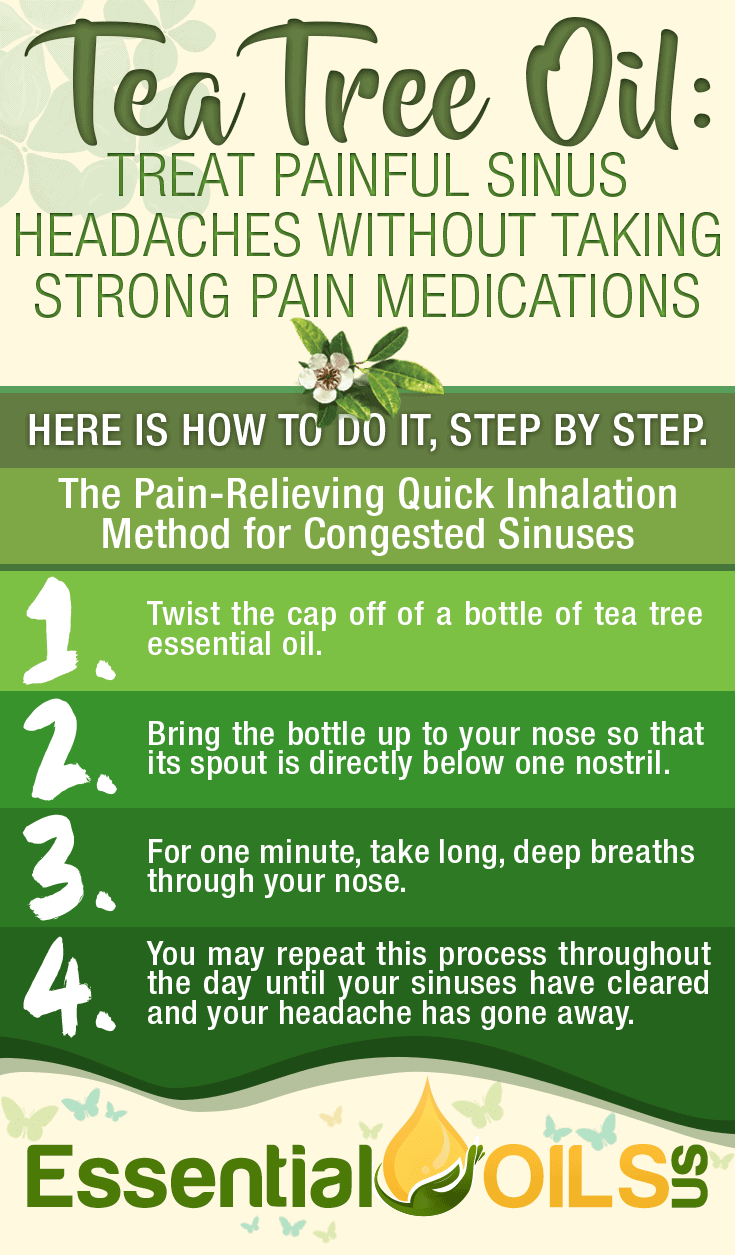
Tea Tree Essential Oil FAQ
What is Tea Tree Essential Oil?
Also known as melaleuca oil, tea tree oil comes from the narrow-leaved paperbark tree that is native to coastal Australia. The tree belongs to the myrtle family (source).
For centuries, the oil has been used for its many health benefits. Because of its strong minty scent, it is also used as a deodorizer.
What are the Uses of Tea Tree Essential Oil?
Tea tree essential oil is renowned for its potent antibacterial, antiseptic, anti-fungal, anti-inflammatory and antimicrobial properties. In addition, the oil is used as an insecticide and deodorizer.
What is the Composition of Tea Tree Essential Oil?
The chemical compounds in tea tree essential oil are Alpha Pinene, Beta Pinene, Sabinene, Myrcene, Alpha Phellandrene, Alpha Terpinene, Limonene, Cineole, Gamma Terpinene, Para Cymene, Terpinolene, Linalool, Terpinenol and Alpha Terpineol.
How is Tea Tree Essential Oil Made?
Tea tree essential oil is made using the steam distillation process. First, the leaves of the tree are dried. Then, high-pressure steam is passed through them. This steam is collected and the water and oil are separated. The oil that has been separated is tea tree essential oil.
Does Tea Tree Essential Oil Work?
Many studies have proven that tea tree essential oil is highly effective thanks to the various healing properties that come from its chemical composition.
How is Tea Tree Essential Oil Taken?
Pediatric
For children, tea tree oil can be safely inhaled for its decongestant properties or applied topically to the skin to treat a variety of skin conditions as well as cuts and scrapes. It may also be applied to the skin as a bug repellent. However, some children may experience allergic reactions or skin irritation as the result of applying the oil directly to the skin. If this is the case, cease use immediately (source).
Tea tree oil cannot be ingested by children. Ingestion of tea tree oil can result in vomiting, rash and coma due to its potentially toxic nature.
Adult
Adults can safely apply tea tree oil topically to the skin to treat a variety of infections and skin conditions. When applied to the skin, the oil also acts as a bug repellent. Adults may inhale the oil for its effectiveness as a decongestant.
Some adults may experience skin irritation or rash when applying the oil to the skin. Also, some adults may have an allergic reaction to the oil when it is applied directly to the skin. If this is the case, refrain from using it.
Tea tree oil should never be ingested by adults because it may be toxic. Ingestion of tea tree essential oil can result in vomiting, rash and coma.
Is Tea Tree Essential Oil Safe?
Tea tree oil is safe to apply topically to the skin as long as the user is not allergic. It is also safe to inhale. However, tea tree oil should never be ingested.
What are the Side Effects of Tea Tree Essential Oil?
Tea tree oil may cause skin irritation or rash when applied directly to the skin. Ingestion of tea tree oil may be toxic and can result in vomiting, rash and coma (source).
Medical Interactions
There are no known medical interactions.
Pregnant Women
Tea tree oil is likely safe for pregnant women when applied topically to the skin. However, pregnant women should never ingest tea tree oil.
Children
It is safe for children to inhale tea tree essential oil. Children may apply the oil topically to the skin but should stop using it if it causes skin irritation or rash. Children should never ingest tea tree essential oil.
Ingesting Tea Tree Essential Oil
Tea tree essential oil is not safe to ingest.
Facts About Tea Tree Essential Oil
Botanical name: Melaleuca alternifolia
Common method of extraction: steam distillation
Plant part typically used: leaves
Color: pale yellow
Consistency: thin
Strength of aroma: strong
Aromatic scent: mint
Blends well with: peppermint, rosemary, lavender, eucalytpus
Where Can I Buy Tea Tree Essential Oil?
Tea tree essential oil is a very popular essential oil that can be found in many drug stores, grocery stores and specialty stores. It is also available online.
Tea Tree Essential Oil Benefits Infographic
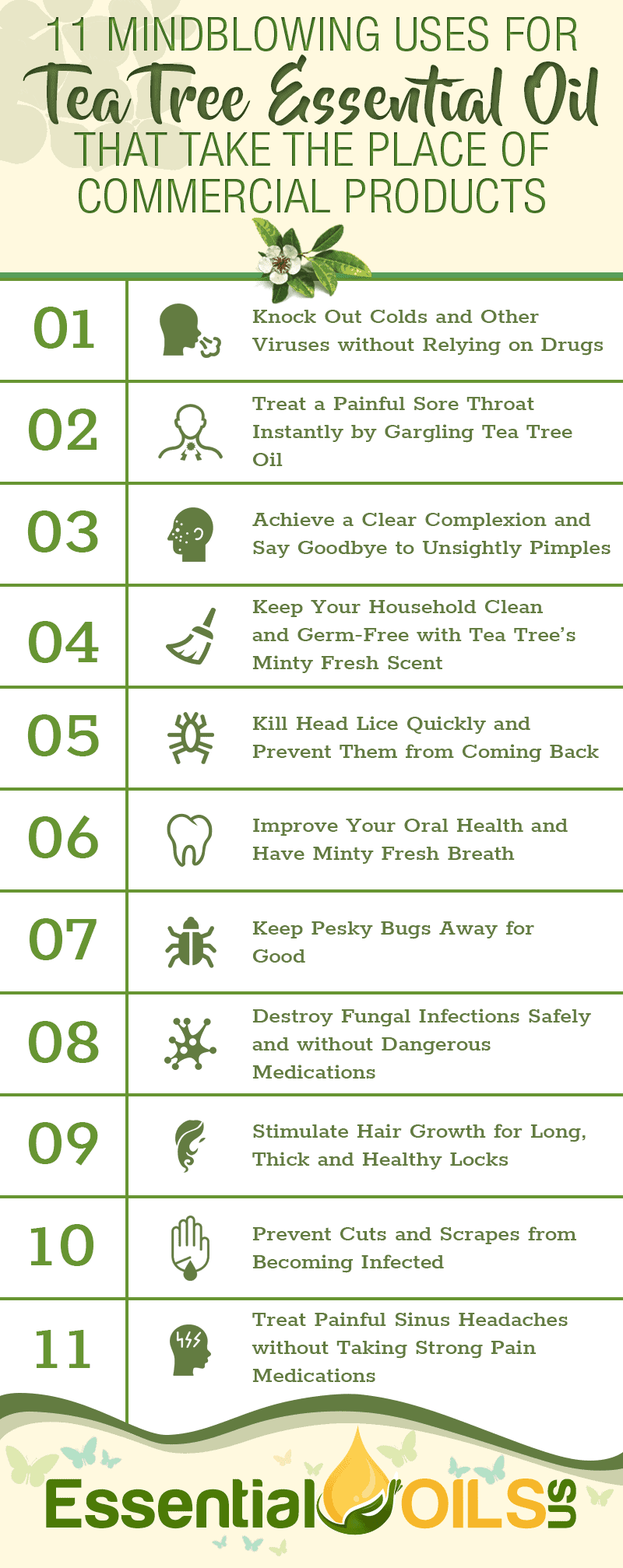
Summary
Few things can knock out such a wide variety of infections like tea tree essential oil. Boasting a number of healing properties, this oil can kill most viruses, fungal infections and bacterial infections quickly. Plus, its stimulating minty scent masks bad odors.
If you like to use tea tree essential oil, let us know your favorite use for it by leaving us a comment. Share this article with anyone you know who is interested in this amazing essential oil!

